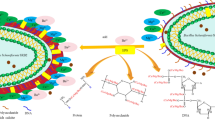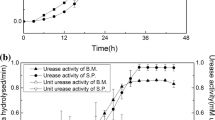Abstract
Implication of ureolytic biocalcification process as an efficient carbon dioxide sequestration technology was evaluated with Bacillus megaterium culture growing in a closed environment system. In three experimental sets containing either 35 % v/v CO2 in headspace (set 1) or 50 mM urea in solution (set 3) or both (set 2), change in headspace CO2, soluble calcium, and pH were monitored during 8 days of incubation. In absence of urea, headspace CO2 content continued to increase in set 1 (up to 48 % v/v) without any carbonate precipitation. However, carbonate precipitation were obvious in urea containing sets (sets 2 and 3) utilizing all the added calcium (25 mM) in just 2 and 6 days, respectively. No headspace CO2 could be detected in set 2 at the end of experimental period, and analysis suggested that this was majorly (>53 %) attributed to the solubility trapping phenomenon. Scanning electron microscopy (SEM) and X-ray diffraction (XRD) analysis revealed that the precipitates were made up of calcite and major fraction of vaterite polymorph of CaCO3.




Similar content being viewed by others
References
APHA (2005). Standard methods for examinations of water and wastewater (21st ed.) Washington, DC
Cacchio, P., Contento, R., Ercole, C., Cappuccio, G., Martinez, M. P., & Lepidi, A. (2004). Involvement of microorganisms in the formation of carbonate speleothems in the Cervo cave (l'Aquila–Italy). Geomicrobiol Journal, 21, 497–509.
Chou, C., Seagren, E., Aydilek, A., & Lai, M. (2011). Biocalcification of sand through ureolysis. Journal of Geotechnical and Geoenvironmental Engineering, 137, 1179–1189.
De Muynck, W., Debrouwer, D., Belie, N. D., & Verstraete, W. (2008). Bacterial carbonate precipitation improves the durability of cementitious materials. Cement and Concrete Research, 38, 1005–1014.
De Vrind-de, Jong E. W. & de Vrind, J. P. M. (1997). Algal deposition of carbonates and silica. In: Banfiel J. F., Nealson K. H. (Eds.) Geomicrobiology: interactions between microbes and minerals. Reviews in Mineralogy, 35, 267–307.
Dittrich, M., Kurz, P., & Wehrli, B. (2004). The role of autotrophic picocyanobacteria in calcite precipitation in an oligotrophic lake. Geomicrobiology Journal, 21, 45–53.
Dittrich, M., Müller, B., Mavrocordatos, D., & Wehrli, B. (2003). Induced calcite precipitation by Cyanobacterium synechococcus. Acta Hydrochimica et Hydrobiologica, 31, 162–169.
Doney, S. C., Fabry, V. J., Feely, R. A., & Kleypas, J. A. (2009). Ocean acidification: the other CO2 problem. Annual Review of Marine Science, 1, 169–192.
Fujita, Y., Ferris, F. G., Lawson, R. D., Colwell, F. S., & Smith, R. W. (2000). Calcium carbonate precipitation by ureolytic subsurface bacteria. Geomicrobiol Journal, 17, 305–318.
Gorna, K., Hund, M., Vucak, M., Gröhn, F., & Wegner, G. (2008). Amorphous calcium carbonate in form of spherical nanosized particles and its application as fillers for polymers. Materials Science and Engineering A, 477, 217–225.
Hammes, F., & Verstraete, W. (2002). Key role of pH and calcium metabolism in microbial carbonate precipitation. Reviews in Environmental Science and Biotechnology, 1, 3–7.
Jones, A. G. (2002). Crystallization process systems. Oxford: Butterworth-Heinemann.
Kirboga, S., & Öner, M. (2013). Investigation of calcium carbonate precipitation in the presence of carboxymethyl inulin. Cryst Eng Comm, 15, 3678–3686.
Langdon, C., Broecker, W. S., Hammond, D. E., Glenn, E., Fitzsimmons, K., et al. (2003). Effect of elevated CO2 on the community metabolism of an experimental coral reef. Global Biogeochemical Cycles, 17, 1011.
Lim, M., Han, G.-C., Ahn, J.-W., & You, K.-S. (2010). Environmental remediation and conversion of carbon dioxide (CO2) into useful green products by accelerated carbonation technology. International Journal of Environmental Research and Public Health, 7, 203–228.
Marvasi, M., Gallagher, K. L., Martinez, L. C., Pagan, W. C. M., Rodríguez Santiago, R. E., Vega, G. C., et al. (2012). Importance of B4 medium in determining organomineralization potential of bacterial environmental isolates. Geomicrobiology Journal, 29, 916–924.
Mitchell, A. C., Dideriksen, K., Spangler, L. H., Cunningham, A. B., & Gerlach, R. (2010). Microbially enhanced carbon capture and storage by mineral-trapping and solubility-trapping. Environmental Scienceand Technology, 44, 5270–5276.
Mitchell, A. C., & Ferris, F. G. (2005). The coprecipitation of Sr into calcite precipitates induced by bacterial ureolysis in artificial groundwater: temperature and kinetic dependence. Geochimica et Cosmochimica Acta, 69, 4199–4210.
Rivadeneyra, M. A., Parraga, J., Delgado, R., Ramos-Cormenzana, A., & Delgado, G. (2004). Biomineralization of carbonates by Halobacillus trueperi in solid and in liquid media with different salinities. FEMS Microbiology Ecology, 48, 39–46.
Rodriguez-Navarro, C., Jimenez-Lopez, C., Rodriguez-Navarro, A., Gonzalez-Muñoz, M. T., & Rodriguez-Gallego, M. (2007). Bacterially mediated mineralization of vaterite. Geochimica et Cosmochimica Acta, 71, 1197–1213.
Sarda, D., Choonia, H. S., Sarode, D. D., & Lele, S. S. (2009). Biocalcification by Bacillus pasteurii urease: a novel application. Journal of Industrial Microbiology and Biotechnology, 36, 1111–1115.
Shen, Y., Xie, A., Chen, Z., Xu, W., Yao, H., Li, S., et al. (2007). Controlled synthesis of calcium carbonate nanocrystals with multi-morphologies in different bicontinuous microemulsions. Materials Science and Engineering A, 443, 95–100.
Solomon, S., Qin, D., Manning, M., Chen, Z., Marquis, M., et al. (2007). Climate Change 2007: The physical science basis: contribution of working group I to the fourth assessment report of the intergovernmental panel on climate change. New York: Cambridge Univ. Press.
Van Lith, Y., Warthmann, R., Vasconcelos, C., & Mckenzie, J. A. (2003). Sulphate-reducing bacteria induce low-temperature Ca-dolomite and high Mg-calcite formation. Geobiology, 1, 71–79.
Zamarreno, D. V., Inkpen, R., & May, E. (2009a). Influence of temperature on biocalcification by non-sporing freshwater bacteria. Geomicrobiology Journal, 26, 1–12.
Zamarreno, D. V., May, E., & Inkpen, R. (2009b). Influence of environmental temperature on biocalcification by non-sporing freshwater bacteria. Geomicrobiology Journal, 26, 298–309.
Acknowledgement
This study was financially supported by NRF on development of biomimetic technology for acid soil rehabilitation using biocalcification process along with partial contribution of INHA University Research Grant.
Author information
Authors and Affiliations
Corresponding author
Rights and permissions
About this article
Cite this article
Lee, J., Kim, C.G. & Mahanty, B. Mineralization of Gaseous CO2 by Bacillus megaterium in Close Environment System. Water Air Soil Pollut 225, 1787 (2014). https://doi.org/10.1007/s11270-013-1787-7
Received:
Accepted:
Published:
DOI: https://doi.org/10.1007/s11270-013-1787-7




